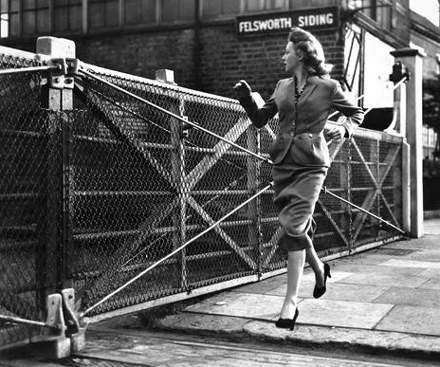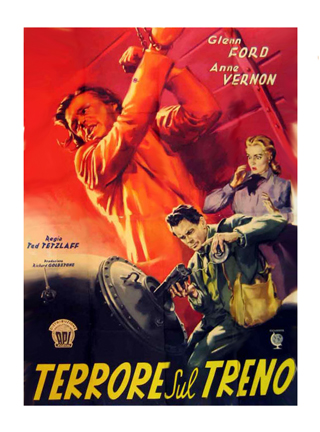
 |
|
|
|
"Can They... Will they... Stop that Terror on a Train? Suspense movies involving a perilous race against the clock have been around since the earliest serials, and the "ticking time bomb" scenario is so pervasive that by now there must be twenty thousand films and TV shows devoted to it. But the modern jeopardy-suspense thriller didn't really get rolling until the postwar years, when the mayhem being reported every day in the papers made the bare facts of a bomb threat acceptable fare for a full-length feature. The ultimate time bomb story came early, in 1950: the Boulting Brothers' Seven Days to Noon is about a mad scientist who commits nuclear blackmail. As time runs out and the bomb cannot be located, all of London must be evacuated. 
The early 1950s saw the MGM studio facing a shrinking theatrical audience yet maintaining an expensive overseas operation in England. Big, successful pictures like Ivanhoe were made there, and in 1953 a quickie thriller called Time Bomb. The crew and most of the actors are English, but the Hollywood star Glenn Ford was brought in to enhance the picture's marketability. It was eventually re-titled Terror on a Train for America. The director is the former cameraman Ted Tetzlaff, who had made the solid RKO hits The White Tower (also starring Ford) and The Window. In its day Terror was a fairly innovative suspense thriller. A young saboteur (Victor Maddern) is seen meddling with tools and explosives around a trainload of naval mines in Birmingham, just before its scheduled departure for Portsmouth. Presuming that a bomb has been set, the authorities park the eleven rail cars on a siding in Felsworth, and evacuate the lower-income housing area around it. Canadian engineer Peter Lyncort (Glenn Ford) has wartime experience with mines. The police arrive to enlist Peter's help only a few minutes after his wife Janine (Anne Vernon of The Umbrellas of Cherbourg) walks out on him. She's bored of dull Birmingham and Peter's inattentiveness, and says she's going back to France. While a railroad cop traces the saboteur, Peter sizes up the situation. Assuming that the bomb has been timed to go off upon arrival in Portsmouth, he has only a few hours to find it. There are dozens of mines, each of which requires delicate handling. With the trains not running, Janine has second thoughts about her marriage. Peter is not home so she waits at their favorite restaurant. Official Warrilow (Maurice Denham) volunteers to help Peter examine the mines, and they work feverishly through the night. Will they catch the saboteur? What will Janine do when she learns that Peter is risking his life defusing the mines? 
Terror on a Train has a number of plusses going for it. Glenn Ford is an instant audience identification figure. Striking a perfect balance between glamorous leading man and "everyman" qualities, his powerful but non-aggressive star appeal is ideal for a wide range of leading roles. Most of the British cast is excellent, with familiar faces like Harcourt Williams and Bill Fraser showing up in functional parts. The most endearing of them is Herbert C. Walton as "Old Charlie", a senile resident of Felsworth Courts. Charlie slips away during the evacuation and shows up at the railroad tracks, eager to play on the trains. The cops show exemplary kindness and restraint with the mischievous old coot. The storyline dispenses with the kind of dialogue scenes that establish character back-stories and psychological motivations. This is the kind of no-frills mounting jeopardy construction that American director Andrew L. Stone would soon use for a run of six or seven successful thrillers: The Night Holds Terror, Julie, Cry Terror!, The Last Voyage. The crisis situation is squeezed for a maximum of tension. That doesn't quite happen in Tetzlaff's picture. The train of the title is only in motion for a couple of minutes. It sits stock still on an empty siding for hours, which means that most of Glenn Ford's role consists of climbing between flat cars and unscrewing screws. As Peter Lyncort already knows all there is to know about defusing Navy mines, the only problem is finding the booby-trapped mine before the clock runs out. The story concentrates on the business of evacuating hundreds of mostly elderly people. The Birmingham police are made to seem highly efficient, and for human interest these are probably the film's best scenes. The screenplay earns an "A" for detail but allows us to anticipate most every plot twist. A major casualty of the screenplay is actress Anne Vernon. Previously seen as a sexy addition to French comedies, Ms. Vernon is given a one-note role, acting petulant and spoiled. Janine passes the night essentially doing nothing, and then predictably rushes to hubby's side at the worst possible moment. The actress must have grabbed at the opportunity to play opposite one of America's rising stars, but neither the script nor the direction allow her to develop much audience sympathy. 
Overall, we're given too much slack time to question various story points. How come this incredibly hazardous munitions cargo is being transported all on one train? Why isn't it heavily guarded? Why is the Felsworth Siding a good place to park it, when so many innocent civilians live only a few feet away? We also might ask why the mines are needed at all, considering that the country is not at war. The world is littered with unexploded, forgotten mines on land and sea, that do little more than kill innocent civilians, mostly children. We're supposed to be hoping and praying that Peter Lyncort can save the shipment? Actor Victor Maddern, initially a specialist in 'spiv' roles, plays the saboteur. American horror fans know him for his monstrous hunchback in Blood of the Vampire. Maddern's saboteur is a disagreeable creep whose motives are never spelled out. Is he working for a foreign government or is he some kind of radical peacenik, the kind that in movies are always threatening world security? When finally caught, the terrorist is still hoping that all the mines will detonate and take out several city blocks. The cops force him to cooperate by handcuffing him to the train car: if there's still a danger, he'll have to either speak up or be blown up. The movie emphasizes that the saboteur is a coward, but doesn't want us to ask anything else about him. The inference is that all the new weaponry being manufactured and stockpiled would be completely safe, if it weren't for those dastardly Enemies of Freedom. Terror on a Train delivers the last-minute twist that has since become standard plotting. As is the pattern in these films, once the threat is resolved the film ends almost immediately. If one is looking for a truly superlative time bomb thriller, the one to see is Powell & Pressburger's The Small Back Room. Its bomb disposal expert must contend with all manner of personal and professional problems, as well as fiendishly tricky bombs. 
The Warner Archive Collection DVD-R of Terror on a Train is an excellent encoding of this very attractively shot B&W picture. Made just before the changeover to widescreen, the framing is a proper flat screen 1.37:1. The cinematography is by Freddie Young, later the famed cameraman for two of David Lean's epics. Most of the show takes place at night, with entire city blocks lit up for the filming. One handsome shot cranes up from the abandoned railway cars, over some walls and right to a noisy pub where the evacuation will soon begin. The odd trailer begins with announcer George Fenneman spinning a globe. He says that, although few of us will visit there, MGM's cameras have gone to England to tell an exciting suspense story. He then narrates a curiously thorough digest version of the movie's first act. Just as in the film, the trailer stresses the authenticity of the evacuation preparations. The presence of star Glenn Ford is practically an afterthought. It's no wonder that Terror on a Train is one of his least-known pictures.
On a scale of Excellent, Good, Fair, and Poor,
Terror on a Train rates:
Reviews on the Savant main site have additional credits information and are often updated and annotated with reader input and graphics. Also, don't forget the 2011 Savant Wish List. T'was Ever Thus.
Review Staff | About DVD Talk | Newsletter Subscribe | Join DVD Talk Forum |
| ||||||||||||||||||